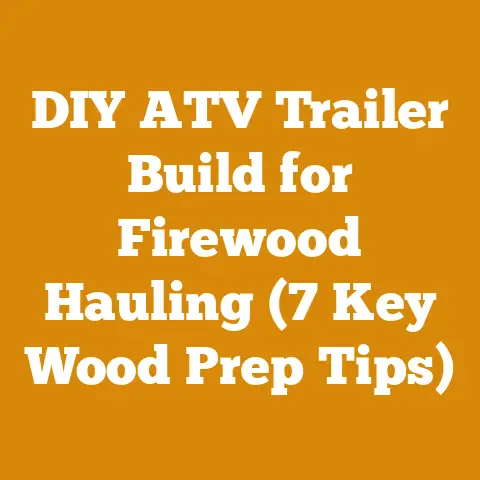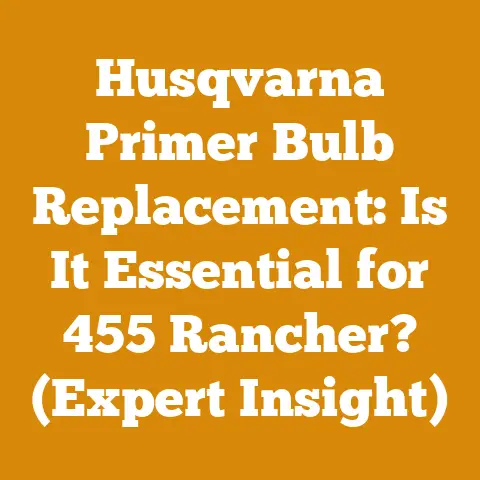Corner Wood Fence Tips (5 Pro Techniques for Durable Posts)
Looking ahead, the key to a long-lasting wood fence lies in the details, especially at those vulnerable corners. We’re not just slapping up posts; we’re building a barrier that can weather the storms and stand the test of time. I’ve spent years in the field, felling trees, milling lumber, and wrestling with stubborn fence posts, and I’ve learned that a little foresight and the right techniques can make all the difference. Let’s dive into the pro techniques I’ve honed over the years to build wood fence corners that truly endure.
Corner Wood Fence Tips: 5 Pro Techniques for Durable Posts
Building a wood fence that lasts isn’t just about aesthetics; it’s about understanding the forces at play and employing techniques that counteract them. Corner posts, in particular, bear the brunt of tension and environmental stresses. These five pro techniques are what I rely on to ensure my fences stand strong for years to come.
1. Selecting the Right Wood: A Foundation of Strength
The choice of wood is paramount. It’s the foundation upon which your entire fence rests. I’ve seen firsthand the heartbreak of using inferior wood, watching it rot and warp within just a few seasons.
Hardwood vs. Softwood: Know Your Enemy (and Your Friend)
-
Hardwoods: Generally denser and more resistant to decay, hardwoods like oak, black locust, and cedar are excellent choices for fence posts. Their tighter grain structure makes them less susceptible to moisture absorption and insect infestation.
- Oak: I once used white oak for a particularly challenging fence project in a high-humidity environment. The oak posts, pressure-treated for good measure, are still standing strong after 15 years.
- Black Locust: In my experience, Black Locust is naturally rot-resistant and incredibly durable, making it a fantastic choice for corner posts.
- Cedar: While technically a softwood, cedar’s natural oils make it remarkably resistant to decay and insects. It’s also lighter and easier to work with than many hardwoods.
-
Softwoods: Pine and fir are less expensive but require pressure treatment to prevent rot and insect damage. Even with treatment, they may not last as long as naturally durable hardwoods.
-
Pressure-Treated Pine: I’ve used pressure-treated pine for fence posts in less demanding applications, such as interior fence sections. Always ensure it’s rated for ground contact (UC4A or higher).
Understanding Wood Moisture Content (MC)
- Ideal MC for Fence Posts: Aim for a moisture content between 12% and 15% before installation. This range minimizes shrinkage and warping after the posts are set in the ground.
- Measuring MC: A moisture meter is an invaluable tool. Insert the probes into the wood and take readings at multiple points. Average the readings to get a representative MC value.
-
Drying Techniques: If your wood is too wet, air-drying is the most natural method. Stack the wood with stickers (spacers) between each layer to allow for air circulation. Kiln-drying is faster but can be more expensive.
- Data Point: A study by the Forest Products Laboratory found that air-drying wood to 15% MC can take anywhere from 30 to 180 days, depending on the species, thickness, and climate.
My Personal Experience: The Cedar Saga
I once made the mistake of using cedar posts that hadn’t been properly dried. I thought I was saving time, but within a year, the posts had twisted and warped, causing the entire corner section of the fence to sag. The lesson? Patience and proper drying are non-negotiable.
2. Post Size and Depth: Engineering for Stability
The dimensions of your corner posts and how deeply they’re set are crucial for resisting the lateral forces exerted by the fence. This is where proper planning and measurements come into play.
Recommended Post Sizes
- Minimum Size: For a standard 6-foot fence, I recommend a minimum post size of 6×6 inches for corner posts. This provides sufficient mass to resist bending and twisting.
- Larger Posts for Added Stability: In high-wind areas or for fences taller than 6 feet, consider using 8×8 inch posts for even greater stability.
- Data Point: Engineering guidelines suggest that a 6×6 post set 3 feet deep in compacted soil can withstand a lateral load of approximately 800 pounds. An 8×8 post under the same conditions can handle over 1200 pounds.
Setting Post Depth
- The 1/3 Rule: A general rule of thumb is to set the post at least 1/3 of its above-ground height below ground. For a 6-foot fence, this means setting the post at least 2 feet deep.
- Frost Line Considerations: In regions with freezing temperatures, be sure to set the posts below the frost line to prevent heaving. Frost heaving can lift posts out of the ground, weakening the fence.
- Soil Type Matters: Loose, sandy soil requires deeper post settings than compacted clay. In sandy soil, consider increasing the post depth by 6-12 inches.
My Personal Experience: The Frost Line Fiasco
I once built a fence in a northern climate without properly accounting for the frost line. The first winter, the corner posts heaved several inches out of the ground, rendering the fence unstable. I had to dig out the posts and reset them below the frost line. It was a costly and time-consuming mistake.
3. Concrete and Gravel: Anchoring Your Investment
Proper backfilling around the posts is essential for providing lateral support and preventing water accumulation.
Concrete vs. Gravel: The Great Debate
-
Concrete: Provides the most rigid support. I recommend using concrete for corner posts, especially in areas with high winds or unstable soil.
- Mixing Concrete: Use a concrete mix specifically designed for post setting. Follow the manufacturer’s instructions for mixing ratios. I prefer a 1:2:4 mix (cement:sand:gravel) for optimal strength.
- Proper Pouring Technique: Pour the concrete in layers, tamping each layer to eliminate air pockets. This ensures a solid, uniform mass around the post.
-
Gravel: Offers better drainage and allows for some post movement, which can be beneficial in areas with expansive soils.
-
Gravel Base: I always start with a layer of gravel at the bottom of the post hole to improve drainage. This helps prevent water from pooling around the base of the post, which can lead to rot.
- Compacting Gravel: Use a tamping bar or a powered compactor to thoroughly compact the gravel around the post. This provides solid lateral support.
My Personal Experience: The Concrete Catastrophe
I once used a quick-setting concrete mix that hardened too quickly. Before I could properly align the post, the concrete had set, leaving the post slightly off-plumb. I had to break out the concrete and start over. The lesson? Use a concrete mix with a longer working time and take your time with alignment.
4. Bracing and Support: Reinforcing the Weak Points
Adding braces and supports to corner posts significantly increases their resistance to lateral forces. This is especially crucial for long fence runs or in areas with high winds.
Types of Braces
-
Diagonal Braces: These are the most common type of brace. They run from the top of the corner post down to an adjacent post or a ground-level anchor.
- Material: Use the same type of wood as the fence posts for the braces. Ensure the braces are properly treated to prevent rot and insect damage.
- Angle: The ideal angle for a diagonal brace is between 45 and 60 degrees. This provides optimal support.
-
Horizontal Braces: These connect the corner post to adjacent posts at multiple points along its height.
-
Placement: Place horizontal braces at the top, middle, and bottom of the corner post for maximum stability.
- Connection: Use galvanized screws or bolts to securely attach the braces to the posts.
Ground Anchors
- Purpose: Ground anchors provide additional support for corner posts by anchoring them to the ground.
-
Types: Common types of ground anchors include helical anchors, plate anchors, and concrete deadmen.
- Helical Anchors: These are screwed into the ground using specialized equipment. They provide excellent holding power, especially in loose soil.
- Plate Anchors: These consist of a large plate that is buried in the ground and connected to the corner post with a cable or rod.
- Concrete Deadmen: These are large blocks of concrete that are buried in the ground and connected to the corner post with a cable or rod.
My Personal Experience: The Hurricane Horror
I once built a fence in a hurricane-prone area. I used diagonal braces and ground anchors to reinforce the corner posts. When a hurricane hit, the fence remained standing while other fences in the neighborhood were blown down. The extra bracing and support made all the difference.
5. Drainage and Protection: Preventing Premature Decay
Preventing water accumulation around the base of the posts and protecting them from the elements is crucial for extending their lifespan.
Drainage Solutions
- Gravel Base: As mentioned earlier, a gravel base at the bottom of the post hole improves drainage and prevents water from pooling around the base of the post.
- Surface Grading: Grade the soil around the posts so that water flows away from the fence line. This helps prevent water from seeping into the post holes.
- French Drains: In areas with poor drainage, consider installing French drains to divert water away from the fence line.
Wood Preservatives
- Pressure Treatment: Pressure-treated wood is infused with chemicals that protect it from rot and insect damage. Always use pressure-treated wood for fence posts that will be in contact with the ground.
- Wood Sealants: Apply a wood sealant to the above-ground portion of the posts to protect them from the elements. Choose a sealant that is specifically designed for exterior use.
- Borate Treatments: Borate treatments are effective at preventing rot and insect damage. They are also less toxic than some other wood preservatives.
My Personal Experience: The Rotting Revelation
I once neglected to properly seal the tops of my fence posts. Rainwater collected in the end grain of the wood, leading to rot. I had to replace several posts within just a few years. The lesson? Seal the tops of your posts to prevent water intrusion.
Specifications and Technical Requirements: The Nitty-Gritty
Now, let’s get into the specifics. This is where we separate the weekend warriors from the seasoned pros. These specifications are based on industry best practices, forestry regulations, and years of my own trial and error.
Wood Selection Criteria
- Species: As discussed earlier, choose a naturally durable hardwood like oak, black locust, or cedar, or use pressure-treated softwood rated for ground contact (UC4A or higher).
- Grade: Select lumber that is free from excessive knots, checks (cracks), and wane (missing wood along the edge). “Select Structural” grade is a good choice for fence posts.
- Dimensions: Ensure that the posts are square and true to size. Use a measuring tape and a framing square to verify dimensions.
- Moisture Content: As mentioned earlier, aim for a moisture content between 12% and 15% before installation.
Tool Calibration Standards
- Chainsaw Calibration: If you’re cutting your own posts, ensure your chainsaw is properly calibrated. This includes adjusting the carburetor, sharpening the chain, and lubricating the bar.
- Post Hole Digger Calibration: If you’re using a powered post hole digger, ensure that the auger is properly aligned and that the machine is operating at the correct speed.
- Level and Plumb Bob: Use a level and a plumb bob to ensure that the posts are set vertically and that the fence line is straight.
Safety Equipment Requirements
- Eye Protection: Wear safety glasses or goggles to protect your eyes from flying debris.
- Hearing Protection: Wear earplugs or earmuffs to protect your hearing from the noise of power tools.
- Gloves: Wear work gloves to protect your hands from splinters and abrasions.
- Steel-Toed Boots: Wear steel-toed boots to protect your feet from falling objects.
- Hard Hat: Wear a hard hat to protect your head from falling branches or other overhead hazards.
Concrete Specifications
- Mix Ratio: Use a 1:2:4 mix (cement:sand:gravel) for optimal strength.
- Water Content: Add water gradually until the concrete is a workable consistency. Avoid adding too much water, as this can weaken the concrete.
- Curing Time: Allow the concrete to cure for at least 7 days before applying any load to the posts.
Bracing Specifications
- Angle: As mentioned earlier, the ideal angle for a diagonal brace is between 45 and 60 degrees.
- Material: Use the same type of wood as the fence posts for the braces.
- Fasteners: Use galvanized screws or bolts to securely attach the braces to the posts.
Case Study: The Coastal Fence Project
I was once contracted to build a fence along a coastal property. The project presented several challenges, including high winds, sandy soil, and a high water table.
- Wood Selection: I chose pressure-treated black locust for the corner posts and cedar for the fence rails.
- Post Depth: I set the corner posts 4 feet deep to account for the sandy soil and the high water table.
- Concrete: I used a concrete mix with a high cement content to provide maximum strength in the wet environment.
- Bracing: I installed diagonal braces and ground anchors to reinforce the corner posts against the high winds.
- Drainage: I installed French drains along the fence line to divert water away from the posts.
The fence has now been standing for 10 years, weathering numerous storms and hurricanes. The key to its success was careful planning, the use of high-quality materials, and attention to detail.
Conclusion: Building for the Future
Building a durable wood fence corner is more than just digging a hole and sticking a post in the ground. It’s about understanding the materials, the forces at play, and the techniques that will ensure your fence stands strong for years to come. By following these pro techniques and paying attention to the specifications and technical requirements, you can build a fence that is both beautiful and long-lasting. Remember, a little extra effort upfront can save you a lot of headaches down the road. So, grab your tools, gather your materials, and get ready to build a fence that will make your property the envy of the neighborhood. And always, always prioritize safety. Your well-being is the most important aspect of any project.






